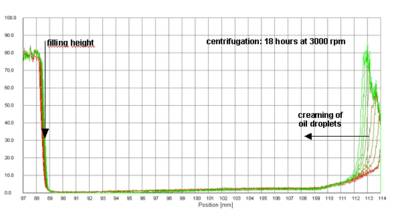Scope
Multisample analytical centrifugation is efficient in characterization and measurement of the speed of destabilizing processes like creaming, coalescence and phase separation [1-3]. It detects very small differences in stability and allows for an accelerated characterization of emulsions without dilution, thus avoiding changes of emulsion properties.
Analytical centrifugation traces the inherent stability, but cannot foresee destabilizing processes that will happen during storage of the sample. But, it will see the results of destabilizing processes far more faster than visual observation. Therefore, to this end a combination with suitable stress tests is the method of choice.
As a demonstration the evaluation of aging of cosmetic creams is presented, which is important in relation to development of new formulations and in quality control of manufactured products. The stability of samples aged during storage at ambient conditions or by a freeze-thaw cycle (accelerated aging) was compared with the initial stability just after manufacturing.
Measurement principle
The Lumifuge 116 employs the STEP technology, which allows to measure the intensity of the transmitted light as function of time and position over the full sample length simultaneously. (Measurement scheme see Fig. 1)
The data are displayed as function of the radial position, as distance from the centre of the rotation (transmission profiles, see Fig. 2).
At the same time up to 8 different samples can be analysed simultaneously at temperatures up to 60 °C.
By means of the available analysis modes ‘Integral Transmission’ (Clarification) and ‘Front Tracking’ the separation behaviour of the individual samples can be compared and analysed in detail.
Experimental/Results
|
|
|

Fig. 2 Evolution of transmission profiles with time - first recorded profile undermost (red), last profile uppermost (green), centrifugation of a cosmetic cream of the o/w type at 1100 x g for 18 hours
The sharp drop in transmission at about 88.5 mm marks the filling height of the sample.
The lowest transmission belongs to the first profile (red). The destabilizing process, separation of an aqueous phase, starts from the bottom of the cell. The boundary water -emulsion is moving upwards (last profile green). That is, the separation process is characterized by creaming of oil droplets inside the continuous aqueous phase. From this it becomes obvious that the cream is an oil-in-water emulsion.
It has to be noted that the cream has a high inherent stability, given the long time and high speed of centrifugation necessary to produce these changes.
The more stable creams exhibited only a small increase of transmission near the cell bottom.
For a comparative investigation therefore the change in transmission of the bottom region was chosen as a measure of stability.
Figure 3 shows the effect of two month of aging at ambient temperature for the most and for the least stable sample.
The just prepared samples are clearly less stable than the samples after 2 month aging at ambient laboratory conditions.

Fig. 3 Change of integral transmission (113 - 114 mm) during centrifugation at 1100 x g for 18 hours - effect of 2 month aging at ambient temperature
However, further flocculation is expected to cause irreversible destabilization. In contrast other aging processes like coalescence and Ostwald Ripening would have led to a direct destabilization.
The effect of accelerated aging by a freeze-thaw cycle (thawing after 24 hours of storage at
-10 °C, compared to the samples not subjected to the freeze-thaw cycle) is depicted in

Fig. 4 Change of integral transmission (113 - 114 mm) during centrifugation at 1100 x g for 18 hours - effect of a freeze-thaw cycle after 2 month aging at ambient temperature
It is readily obvious from this comparison that aging by one freeze-thaw cycle markedly enhances the differences in stability already inherent in the samples before freezing.
As seen the separation of the continuous phase at the bottom is initially slow and speeds up only after a prolonged time of centrifugation. This indicates a stabilizing barrier against creaming (probably a flocculated network). The freeze-thaw cycle obviously reduces the stabilizing barrier causing a marked reduction of the induction period.
In the case investigated the order of stability of the different creams does not change during aging (2 month, or after an additional freeze-thaw cycle), i.e. the inherent stability of the samples as prepared is altered during aging for all samples the same way.
To trace slow destabilizing processes a combination with common accelerated aging tests is the method of choice
References
[1] Characterization and optimization of emulsions Chemistry Preprint Archive, Volume 2002, Issue 6, June 2002, Pages 195-201 [3] Rapid characterization of emulsions for emulsifier selection, quality control and evaluation of stability using multisample analytical centrifugation, T. Sobisch, D. Lerche, 2005, SCI/RSC/SCS conference Cosmetics and Colloids, London 15 February 2005 http://www.soci.org/SCI/groups/col/2005/reports/pdf/gs3257_sob.pdf[2] Stability analyser LUMiFuge 116 for rapid evaluation of emulsion stability and demulsifier selection,
D. Lerche, T. Sobisch, S. Küchler, 2002, http://www.sciencedirect.com/preprintarchive



No comments:
Post a Comment